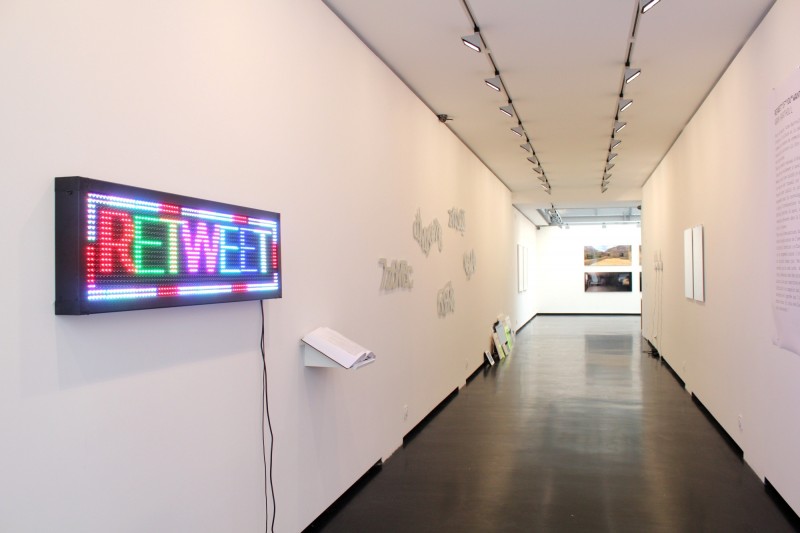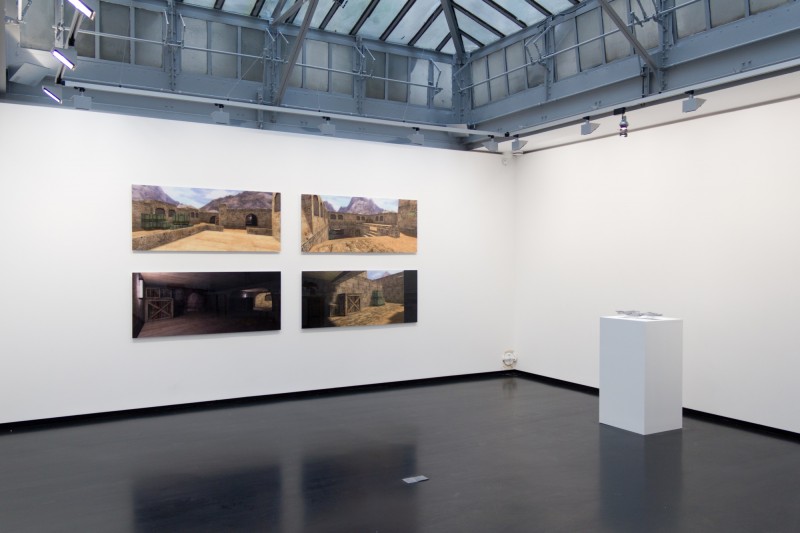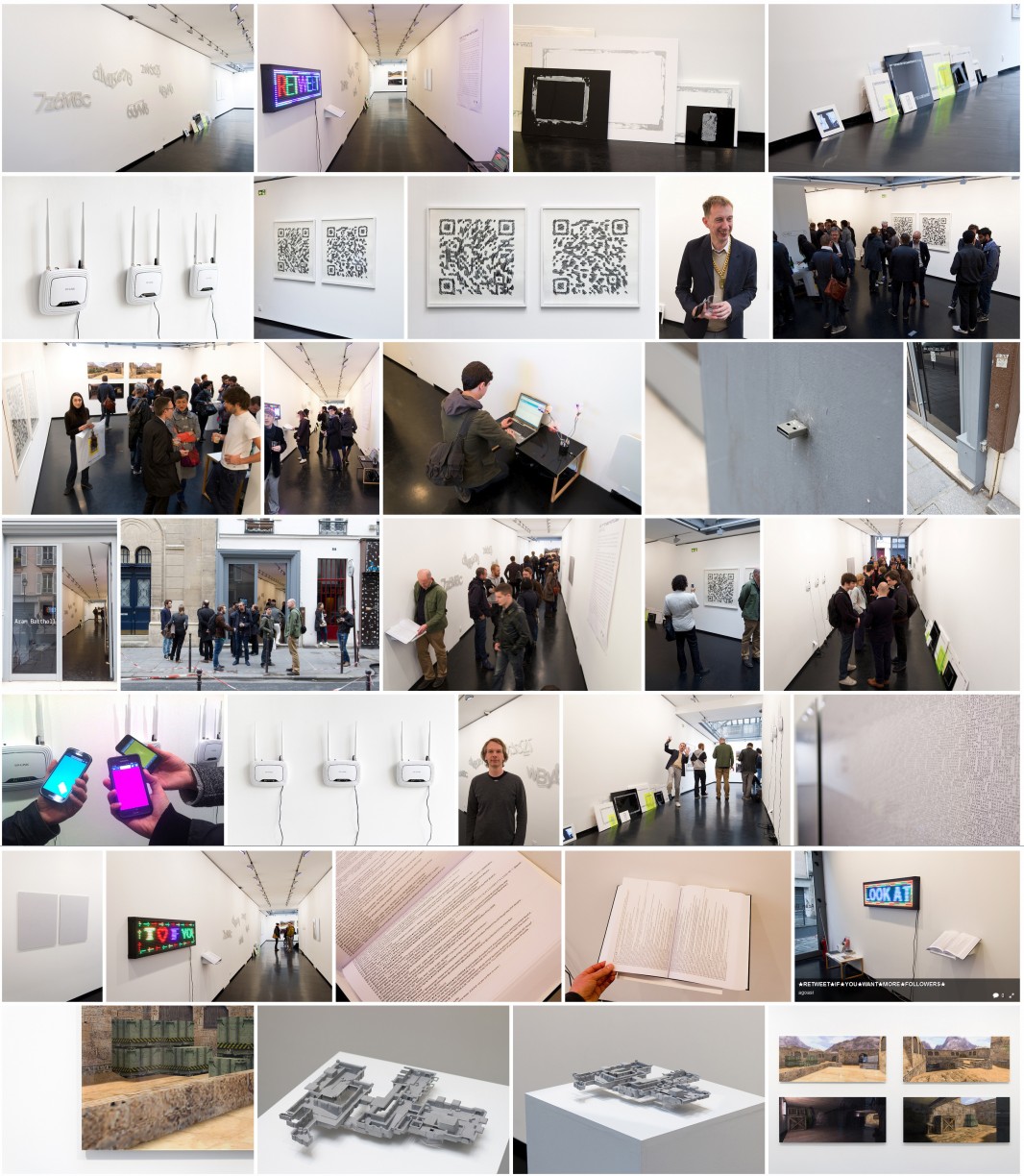Pictures & Texts: Retweet solo show XPO
THX EVERYONE!! OPENING WAS GREAT!!! :)))
★RETWEET★IF★YOU★WANT★MORE★FOLLOWERS★
First solo show in Paris by Aram Bartholl at xpo gallery
17.5.-26.6.2013, opening May 16, 7pm
xpo gallery, Paris
PRESS:
http://www.aqnb.com/2013/05/22/aram-bartholl-xpo-gallery-reviewed/
http://www.damepipi.tv/2013/05/aram-bartholl-retweet-if-you-want-more.html
http://www.fadwebsite.com/2013/05/23/aram-bartholl-exposition-personnelle/
Statement:
Aram Bartholl’s work creates an interplay between internet, culture and reality. The
versatile communication channels are taken for granted these days, but how do they
influence us? According to the paradigm change of media research Bartholl not just
asks what man is doing with the media, but what media does with man. The tension
between public and private, online and offline, technology infatuation and everyday
life creates the core of his producing.
For the show Retweet if you want more followers at xpo gallery, Paris exhibition
Aram Bartholl created a series of new works questioning the Internet immanent
ubiquitous scream for attention. The constant stream of codes, signs and change
force the user to filter, decode and recalibrate every day. Screen scape of high speed
time lines, hidden code, endless video or 3D space invade our minds for ever while
large parts are blocked. The impossible to remember what link was hot last week is
ignored by the calm, hypnotic glow of the screen which makes us smile.
Retweet this now!
Works:
Retweet
LED sign , Book, 120x40x8 cm
Twitter is the most advanced incarnation of todays high-speed online attention craze. What are the
hottest breaking news? Which are the latest trending topics? Gossip never traveled so fast! The fastest
way to spread information on Twitter is to get a lot of retweets on a single tweet. The more user repeat
the original message the more attention it gets. The invitation to ‘RETWEET!’ is a typical tweet format to
generate retweets and thus also more followers which are the currency on twitter. A vast stream of
mostly self-referential tweets containing ‘retweet’ are fired off on twitter every second. In an endless
scream for attention the follow-train runs silently on high speed through the never-ending timeline.
Credits: Greg Leuch
Private Password
b/w monochrome series
C-print, aluminum dibond, acryl, 59×77 cm
Like many other Internet services LinkedIn.com got hacked in summer 2012 and lost its user database
to unknown hackers. A couple months later a part of the encrypted passwords lists was leaked in
forums specialized in decrypting passwords as a ‘computer sport’. Private Password is a series of prints
each showing ca 12.000 clear text passwords of actual LinkedIn users accounts. Each password was
invented by a single individual, complicated enough so it can’t be guessed easily but at the same time
simple enough to memorize it. While online identities became more and more important consumer
hardware of today equals the processing power of super computers from 2000. A password you can
learn by heart without hard training is not a save password any more.
Art Forums
Website and installation
website, PC laptop, USB hub, USB led fans
Art-forums.org is a classic Internet forum website with a default setup of the bulletin board software
php BB. Everyone is invited to register at art-forum.org to discuss art. Internet forums as a place for
direct user interaction represent a massive and important part of Internet culture and online
communication. In the era of FB, Twitter and social web Internet forums with their typical design,
animated emoticons and amateur culture seem outdated although they are more open and interactive
than a FB wall. The same underestimation is true for classic PC hardware culture and its gadgets vs the
new polished monofunctional era of tablet computing. ‘Art-forums.org! The best way to discuss art
online’
Offline Monochrome
Triptych
3 wifi routers, 35x85x3 cm
Disconnected from the Internet each of the three routers broadcasts a single monochrome color.
Visitors have to connect individually to each of the local networks to see every part of the triptych on
their mobile device. Are there enough visitors to see all three at once? How do the mobile screens
correspond with the router installation? What are the screen sizes and the quality of each display?
Questions for a classic wall piece format re-calibrated for 2013.
PrintScreen
Series of monotypes
acryl on paper, canvas, plexi, aluminum, variable from 16×23 to 58×80 cm
Screens are our every day window to digital space. We spend many hours every day looking at screens
of any kind and dimension. Over the last couple decades computer screens have changed constantly in
size and proportions. In more recent years mobile screens became prominent and soon the classic
rectangle will move into glasses vision. Todays screens can display millions of colors, the resolution and
number of dots per inch are getting higher and higher. In a close relationship the printed image has
been under heavy digital influence ever since the computer became mass medium in the production of
the image. The physical screen doesn’t seem to exist as long it is turned on. Its magic glow blinds us
with a constant demand for attention. PrinttSceen is a series of actual monotype prints of my very first
PC black & white CRT tube, my current 2560 x 1600px LCD display and my actual mobile phone touch
screen.
Dust Scapes
Unique,
C-print, alumium dibond, acryl, 141×60 cm
The computer game Counter Strike is one of the most successful first person shooter series and was
especially popular in the first half of the 10’s of the 21st century. With new groundbreaking teamplay
game mechanics it profoundly influenced the game development of the FPS gaming genre. Millions of
gamers have played the game and its scenarios over and over. De_dust used to be one of the most
popular maps in the early days of the game. A vast amount of memory and emotional burst by an
unbelievable large number of players is compressed into this very space. The pure architecture and
absence of the action in Dust Scapes amplifies the collective memory of the space, which only exists in
software on servers.
Dust (model)
Scale 1:333
3D print, laser sinther, alumide, 36 x 33 x 4,5 cm
Dust is a 1:1 scale replica of one of the most played computer game maps in the world. The idea is to
build the 3D model of ‘de_dust’ of the first person shooter game Counter Strike as a permanent
‘building’ from concrete to make this map accessible as a large-scale public sculpture. The dimension
would be 115 x 110 x 15 meter and material is planned to be concrete. Dust (model) is a 1:333 scale
model 3D printed in alumide of the actual planned building and exact copy of the gaming map. The
ongoing development of the whole Dust project was initially commissioned by Rhizome NYC in 2011
Are you human?
Series, unique
aluminum anodised 3mm, laser cut, 44×122 cm to 39×89 cm
CAPTCHA is the acronym for “Completely Automated Public Turing test to tell Computers and Humans
Apart” and was developed in 2000 by information scientists at the Carnegie Mellon University, USA.
Web-based services such as Yahoo require users to recognize and type a randomly generated series of
letters or numbers which appear on the screen as a CAPTCHA image. This test is designed to ensure
that a web form is not being completed by the automatic scripts used by spammers. But sometime it is
also for humans quite hard to decrypt the distorted letters and numbers while the software by
spammers still often succeeds. Unlike every other file on the Internet each code is uniquely generated
by a script on the server and is disposed once it has been used. It will never appear again online in this
very form.
Google Portrait
Series, Google search: Sergey Brin
charcoal on paper, 1m x 1m
A Google Portrait is a drawing that shows the Google search request for a specific person in form of an
encoded URL. Any smart phone is capable to decode the matrix-code with a barcode reader app. In
return the software runs a Google search on the portrayed person and shows the result page in the
browser. ‘Vanity surfing’ is a very popular way to make sure the Google result page does not show
unwanted information. This very page with the 10 most important links represents the contemporary
portrait of a person today. It is the first batch of information we learn about someone. It puts people in
context of their activities and often also displays pictures. The portrait dynamically changes over time
depending on Googles algorithms. While the drawing of the QR code is static the activities of the
portrait person result in a constantly changing online identity
Leave a Reply
You must be logged in to post a comment.




